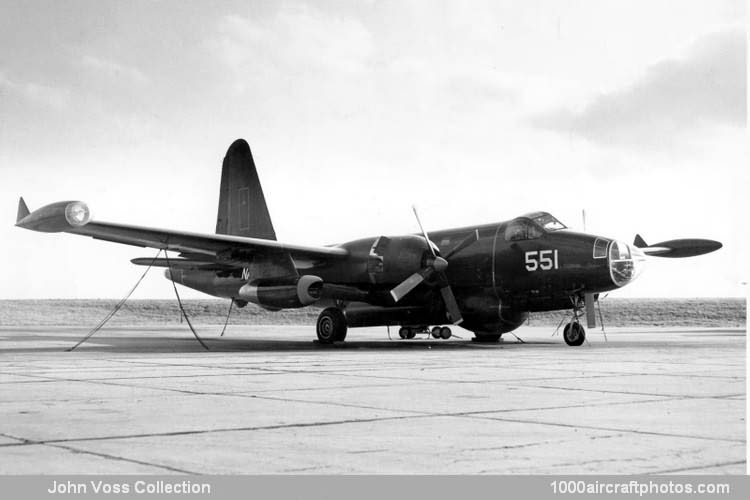01/31/2010. Remarks by Johan Visschedijk: "The P2V-7 was the final production version of the Neptune built by Lockheed in three sub-models (Models 726-45-14, 726-45-17, 826-45-14) with 3,500 hp R-3350-32W Turbo-Compound radial engines and two 3,400 lb (1,542 kg) st J34-WE-36 turbojets. All three versions were fitted with twin 0.50 in (12.7 mm) guns in a dorsal turret and with MAD 'stinger' tail. They were characterized by smaller ventral radome and tip tanks, and revised cockpit with clear, bulged, canopy.
The YP2V-7 prototype (BuNo. 135544) first flew on April 26, 1954, and final delivery of a US-made P2V-7 was effected eight years later. A total of 359 Neptunes, including 48 assembled in Japan by Kawasaki from Lockheed produced parts, were built under the P2V-7 designation as Model 726-45-14s (for the navies of France, Japan and the USA, including five P2V -7Us and four P2V-7LPs), Model 726-45-17s (with revised accommodation, for the same customers and the RAAF), and Model 826-45-14 (for the RCAF).
A fourth sub-version (Model 726-45-18) was produced for the Dutch navy with a metal-covered nose housing four 0.79 in (20 mm) cannon, they were delivered under the military designation P2V-7B. After 1962 the noses were glazed and aircraft brought up to SP-2H standard.
The P2V-7LP comprised four P2V-7s fitted during construction with retractable skis for use in Antarctica by Antarctic Development Squadron Six (VXE-6). All armament and operational items were removed to make room for survey and photographic equipment. The P2V-7U was an electronic-surveillance version for the USAF of which five were built by Lockheed and two were modified from Navy P2V-7 airframes. Later transferred to the Navy and modified as SP-2Hs. The P2V-7S was a modified P2V-7 with Julie/Jezebel submarine-detection gear.
When the Tri-Service designation system was adopted in the USA in 1962, the above mentioned versions of the Neptune then in service were redesignated P-2H (P2V-7), SP-2H (P2V-7S), RB-69A (P2V-7U) and LP-2J (P2V-7LP). In addition, the following designations were assigned to post-1962 modifications.
AP-2H: Four P-2Hs were modified in 1966-67 by E-Systems to carry a TRIM (Trails & Roads Interdiction, Multi-sensor) package for night interdiction operations, all ASW equipment was removed and specialized sensors fitted. The sensor package included AN/APQ-92 search radar, FLIR (forward-looking infra-red), LLLTV (low-light level television), SLAR (side-looking airborne radar), DIANE (Digital Integrated Attack and Navigation Equipment), and 'Black Crow' motor vehicle's engine ignition sensor. Armament consisted of twin 0.79 in (20 mm) cannon in a tail turret and two mini-gun pods and four bombs beneath the wings. Some aircraft were also fitted with a 1.57 in (40 mm) grenade launcher projecting below the bomb bay. Sound suppressing equipment was fitted on the two piston engines and two turbojets.
DP-2H: Designation applying to P-2Hs modified to launch and control drone vehicles.
EP-2H: Designation given to at least three P-2Hs modified by the Navy as airborne relay platforms for UHF telemetry transmitted from drones.
NP-2H: Designation given to one P-2H modified for special tests."
